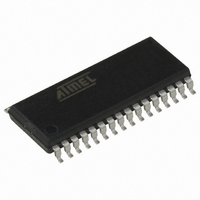AT90PWM316-16SUR Atmel, AT90PWM316-16SUR Datasheet - Page 161

AT90PWM316-16SUR
Manufacturer Part Number
AT90PWM316-16SUR
Description
MCU AVR 16K FLASH 16MHZ 32-SOIC
Manufacturer
Atmel
Series
AVR® 90PWM Lightingr
Datasheet
1.AT90PWM216-16SU.pdf
(359 pages)
Specifications of AT90PWM316-16SUR
Core Processor
AVR
Core Size
8-Bit
Speed
16MHz
Connectivity
SPI, UART/USART
Peripherals
Brown-out Detect/Reset, POR, PWM, WDT
Number Of I /o
27
Program Memory Size
16KB (16K x 8)
Program Memory Type
FLASH
Eeprom Size
512 x 8
Ram Size
1K x 8
Voltage - Supply (vcc/vdd)
2.7 V ~ 5.5 V
Data Converters
A/D 11x10b; D/A 1x10b
Oscillator Type
Internal
Operating Temperature
-40°C ~ 105°C
Package / Case
32-SOIC (7.5mm Width)
For Use With
ATSTK600-SOIC - STK600 SOCKET/ADAPTER FOR SOICATAVRMC200 - KIT EVAL FOR AT90PWM3 ASYNCATAVRFBKIT - KIT DEMO BALLAST FOR AT90PWM2
Lead Free Status / RoHS Status
Lead free / RoHS Compliant
Available stocks
Company
Part Number
Manufacturer
Quantity
Price
- Current page: 161 of 359
- Download datasheet (6Mb)
16.22.1
16.23 PSC Clock Sources
7710E–AVR–08/10
Fault events in Autorun mode
PRUNn and PARUNn bits are located in PCTLn register.
on page 166. See “PSC 1 Control Register – PCTL1” on page 167. See “PSC 2 Control Register
– PCTL2” on page 168.
Note : Do not set the PARUNn bits on the three PSC at the same time.
Thanks to this feature, we can for example configure two PSC in slave mode (PARUNn = 1 /
PRUNn = 0) and one PSC in master mode (PARUNm = 0 / PRUNm = 0). This PSC master can
start all PSC at the same moment ( PRUNm = 1).
To complete this master/slave mechanism, fault event (input mode 7) is propagated from PSCn-
1 to PSCn and from PSCn to PSCn-1.
A PSC which propagate a Run signal to the following PSC stops this PSC when the Run signal
is deactivate.
According to the architecture of the PSC synchronization which build a “daisy-chain on the PSC
run signal” beetwen the three PSC, only the fault event (mode 7) which is able to “stop” the PSC
through the PRUN bits is transmited along this daisy-chain.
A PSC which receive its Run signal from the previous PSC transmits its fault signal (if enabled)
to this previous PSC. So a slave PSC propagates its fault events when they are configured and
enabled.
PSC must be able to generate high frequency with enhanced resolution.
Each PSC has two clock inputs:
Figure 16-39. Clock selection
PCLKSELn bit in PSC n Configuration register (PCNFn) is used to select the clock source.
PPREn1/0 bits in PSC n Control Register (PCTLn) are used to select the divide factor of the
clock.
• CLK PLL from the PLL
• CLK I/O
CLK
CLK
PLL
I/O
PCLKSELn
1
0
CK
PRESCALER
See “PSC 0 Control Register – PCTL0”
AT90PWM216/316
CLK
PSCn
PPREn1/0
161
Related parts for AT90PWM316-16SUR
Image
Part Number
Description
Manufacturer
Datasheet
Request
R

Part Number:
Description:
Manufacturer:
Atmel Corporation
Datasheet:

Part Number:
Description:
MCU AVR 16K FLASH 16MHZ 32-QFN
Manufacturer:
Atmel
Datasheet:

Part Number:
Description:
MCU AVR 16K ISP FLSH 16MHZ32SOIC
Manufacturer:
Atmel
Datasheet:

Part Number:
Description:
8-bit Microcontroller with 16K Bytes In-System Programmable Flash
Manufacturer:
ATMEL [ATMEL Corporation]
Datasheet:

Part Number:
Description:
8-bit Avr Microcontroller With 16k Bytes Of Isp Flash And Usb Controller
Manufacturer:
ATMEL Corporation
Datasheet:

Part Number:
Description:
DEV KIT FOR AVR/AVR32
Manufacturer:
Atmel
Datasheet:

Part Number:
Description:
INTERVAL AND WIPE/WASH WIPER CONTROL IC WITH DELAY
Manufacturer:
ATMEL Corporation
Datasheet:

Part Number:
Description:
Low-Voltage Voice-Switched IC for Hands-Free Operation
Manufacturer:
ATMEL Corporation
Datasheet:

Part Number:
Description:
MONOLITHIC INTEGRATED FEATUREPHONE CIRCUIT
Manufacturer:
ATMEL Corporation
Datasheet:

Part Number:
Description:
AM-FM Receiver IC U4255BM-M
Manufacturer:
ATMEL Corporation
Datasheet:

Part Number:
Description:
Monolithic Integrated Feature Phone Circuit
Manufacturer:
ATMEL Corporation
Datasheet:

Part Number:
Description:
Multistandard Video-IF and Quasi Parallel Sound Processing
Manufacturer:
ATMEL Corporation
Datasheet:











